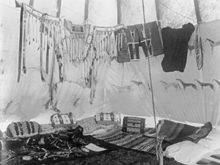Tipi
Tipi (atau ditulis juga teepee atau tepee[1]) adalah sebuah tenda, yang secara tradisional terbuat dari kulit binatang yang di pasang pada tiang-tiang kayu. Tipi modern biasanya memiliki penutup dari kanvas.[2] Tipi dibedakan dengan tenda kerucut lainnya oleh kepulan asap yang keluar dari bagian atas strukturnya.[3][4][5]


Secara historis, tipi telah digunakan oleh Penduduk asli Benua Amerika Dataran Indian yang ada di Great Plains dan Prairie Kanada, Amerika Utara. Tipi umumnya tahan lama,[6] memberikan kehangatan dan kenyamanan di musim dingin,[7] sejuk di musim panas,[note 1]dan kering selama hujan lebat.[8][9] Tipis dapat dibongkar dan dikemas dengan cepat ketika harus pindah dan dapat direkonstruksi dengan cepat setelah menetap di daerah yang baru.[10][11][note 2] Barang yang mudah dibawa-bawa ini penting bagi orang Indian dataran dengan gaya hidup mereka yang kadang-kadang nomaden.[12]
Struktur serupa, lavvu, digunakan oleh Suku Sami di Eropa utara.[13][14][15]
Kata "tipi" menjadi bahasa Inggris yang aslinya berasal dari bahasa Lakota.[16] Kata Lakota thípi [ˈtʰipi] berarti "tempat tinggal" atau "mereka tinggal", dari kata kerja thi, yang berarti "tinggal".[17]


Referensi
- Umum
- Holley, Linda A. Tipis-Tepees-Teepees: History and Design of the Cloth Tipi. Gibbs-Smith, 2007.
- Reginald Laubin, Gladys Laubin, Stanley Vestal, The Indian tipi: its history, construction, and use. Norman: University of Oklahoma Press, 1989, ISBN 978-0-8061-2236-6.
- American Anthropologist. Vol. 16; No. 1. American Anthropological Association of Washington, 1914.
- Kutipan
- ^ Teepee, or tepee, en.wiktionary.org (last visited August 25, 2013). "teepee". www.dict.org.(last visited August 25, 2013). And rarely, "tepee" tepee (dwelling) -- Encyclopædia Britannica
- ^ Laubin, Reginald; Laubin, Gladys (2012). The Indian Tipi: Its History, Construction, and Use (edisi ke-2). University of Oklahoma Press. ISBN 978-0806188522.
- ^ Holley, Linda A. Tipis-Tepees-Teepees: History and Design of the Cloth Tipi.
- ^ The American Antiquarian and Oriental Journal, Volume 24. Edited by Stephen Denison Peet. p253
- ^ History of Dakota Territory, Volume 1. By George Washington Kingsbury. S.J. Clarke Publishing Company, 1915. p147
- ^ Annual Reports, Volume 17, Part 1. 1898. p405
- ^ "Shelter". Anthropological Papers of the American Museum of Natural History, Volumes 5-6. Published by order of the trustees, 1910. p115
- ^ The tipi: a center of native American life. By David Yue, Charlotte Yue. 1984. p. 15.
- ^ Camping and Camp Outfits: A Manual of Instruction for Young and Old Sportsmen. By George O. Shields. Rand, McNally, 1890. p 43
- ^ The North-Americans of yesterday. By Frederick Samuel Dellenbaugh. G.P. Putnam's Sons, 1900. p 204
- ^ Lewis H. Morgan, "Houses and House Life of the American Aborigines," Contributions to N. A. Ethnology, vol. iv., p. 114.
- ^ North American Indians of the Plains. By Clark Wissler. American Museum of Natural History, 1920.
- ^ The People of Tipi Sapa (the Dakotas): Tipi Sapa Mitaoyate Kin. By Sarah Emilia Olden. Morehouse Publishing Company, 1918. p25
- ^ Guide to the museum, first floor. By Museum of the American Indian, Heye Foundation. 1922. p105
- ^ Geological Survey Professional Paper, Volume 670. U.S. Government Printing Office, 1969. p21
- ^ Keoke, Emory Dean; Porterfield, Kay Marie (2009). Encyclopedia of American Indian Contributions to the World: 15,000 Years of Inventions and Innovations. Infobase Publishing. hlm. 264. ISBN 978-1-4381-0990-9.
- ^ Ullrich, Jan (2012) [2008]. New Lakota Dictionary. Lakota Language Consortium. hlm. 525. ISBN 978-0-9761082-9-0. LCCN 2008922508.
- Catatan
- ^ With the sides raised; As seen in: Anthropological papers. 1917. p211
- ^ Lewis H. Morgan notes the Dakota call their skin tents, "wii-ka-yo". The following is an extract of his text:
"When first discovered the Dakotas lived in houses constructed with a frame of poles and covered with bark, each of which was large enough for several families. They dwelt principally in villages in their original area on the head-waters of the Mississippi, the present State of Minnesota. Forced upon the plains by an advancing white population, but after they had become possessed of horses, they invented a skin tent eminently adapted to their present nomadic condition. It is superior to any other in use among the American aborigines from its roominess, its portable character, and the facility with which it can be erected and struck. "[...]" When the tent is struck, the poles are attached to a horse, half on each side, like thills, secured to the horse's neck at one end, and the other dragging on the ground. The skin-covering and other camp-equipage are packed upon other horses and even upon their dogs, and are thus transported from place to place on the plains. This tent is so well adapted to their mode of life that it has spread far and wide among the Indian tribes of the prairie region." (Contributions to N. A. Ethnology, vol. iv., p. 114.)